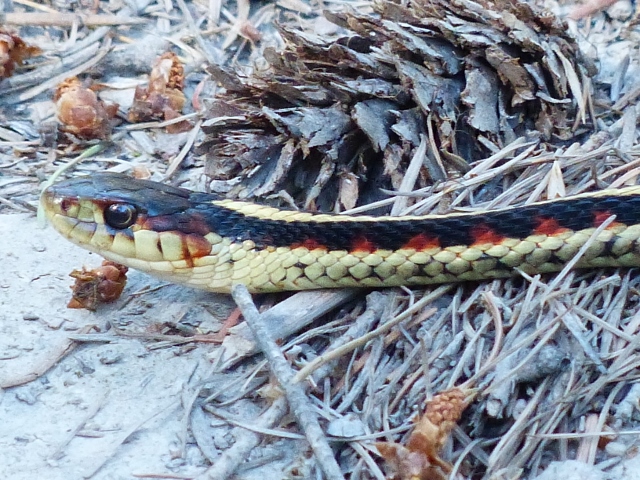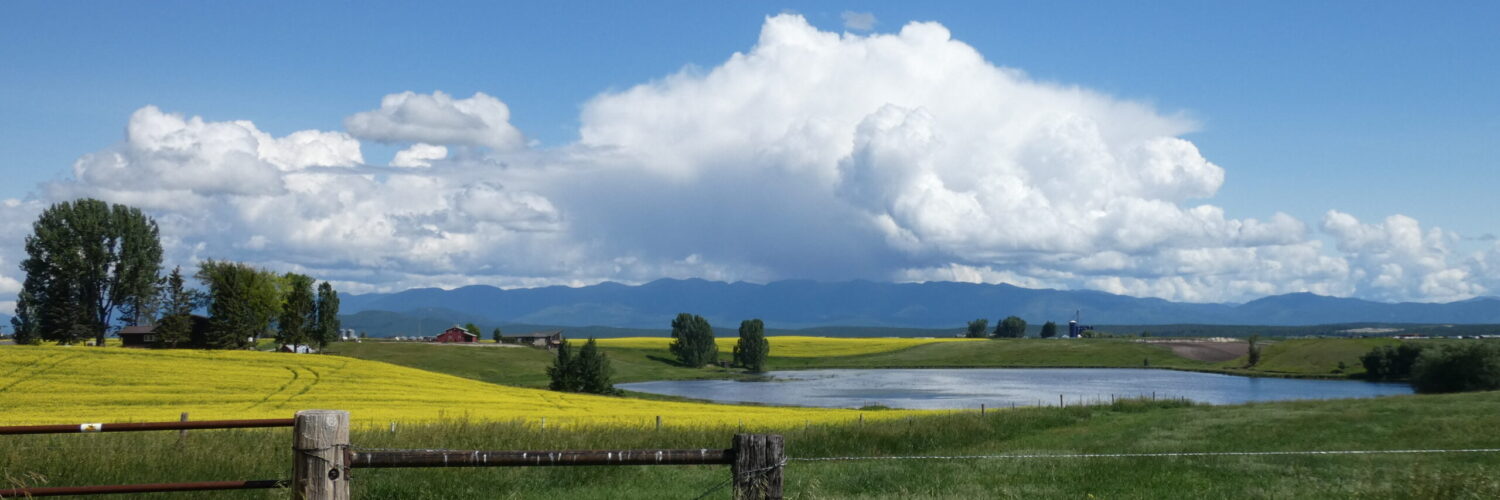by Pat Jaquith
pat@westvalleynaturalists.org

Snakes usually take us by surprise when we are walking along a path or across the lawn. They may register at first as a stick in the path, but our brain suddenly alters the message and I jump as the “stick” slithers away. Here are some different snakes I have encountered in the West Valley.

Taking a second look, the snake that startled me is a Common Gartersnake. There are two variants; this one has three yellow stripes running lengthwise with black or brown between.

This Common Gartersnake (Thamnophis sirtalis) often warmed itself on the rocks near the house steps; although I have become accustomed to seeing it near there, my pulse quickens every time! These cold-blooded animals (ectotherms) bask in the sun to warm up and are often found on trails or roadways. In winter they group together in an abandoned animal den, cavities in rocks, or other underground locations below the frost line. They sometimes travel up to 15 miles between their hibernaculum and their summer range.


This Common Gartersnake is the second variant: the red around the head and along the black stripe sets it apart.


This red dot variant Common Gartersnake was coiled up in a sunny spot along a damp forest trail in the West Valley on 7.02.24. I stepped over a small tree across the trail and nearly stepped on this beautiful creature! Talk about taking one by surprise! According to the Montana Field Guide, females give birth to 6 to 18 live young during summer. Observing the swollen section of the body, I wonder whether it is food (amphibians, slugs, small mammals) passing through the digestive system or uborn offspring. After several minutes, it slowly uncoiled and made its way into a brush pile nearby as I watched from a distance.

Terrestrial Gartersnakes (Thamnophis elegans) may vary in color, but their narrow pale yellow longitudinal stripes are common. As snakes grow, they shed their skin to allow for the increase in size. The “blue” eye is the result of the preparation for shedding. Sometimes it is called the “blue phase”. Terrestrial Gartersnakes have a mildly venomous saliva. If it bites a human, the result is reported to be irritating, causing redness and minor swelling. When handled, they give off a musky odor as a defense mechanism. Although they are reported to live primarily around wet habitats, this one was on our lawn which is on a rocky hillside.
All the Gartersnakes are viviparous, giving birth to several little snakes. Sometimes we have snakes of several sizes eating insects and small rodents we consider pests.
The other species of snake I have seen in the West Valley is a Northern Rubber Boa – but I didn’t get a picture to prove it! It was near one of the ponds in the DNRC land off Farm to Market Road.
Update 6.05.24 I’ve seen another Northern Rubber Boa; here are some pictures to document it!

This one was moving slowly across the wet lawn grass early one morning; I grabbed my phone out of my pocket and took a few photos before returning to the house to get my camera. It had moved only a short distance away in my absence. This snake seemed to resemble a garden hose about 18″ long.


There are three subspecies of Rubber Boas; only the Northern Rubber Boa (Charina bottae bottae) is found in Montana. Montana Field Guides describes them as “slow-moving, secretive, docile, non-venomous snakes.” I attributed its slow movement to the cold temperature; it is interesting to learn that it’s a typical characteristic. “The Northern Rubber Boa feeds on small rodents which they kill through constriction. They are especially effective at locating and consuming nests of young rodents.”
Note about other snake species in Montana: The Montana Natural Heritage Program is a wonderful resource for learning about other species, seeing alternate photos, and seeing where species have been observed. I submitted my photo of the Terrestrial Gartersnake to iNaturalist which a service of the Natural Heritage Program for help with identification. Now, my observation will be added to their information!
When I want to get additional information about a natural subject in Montana, I do a search using ‘MT field guide’ and add the topic: snake, plant, flower, tree, reptile, butterfly… and go from there. It has led me on many informative searches!
For us in the West Valley, Lone Pine State Park has a good selection of information about local topics at the visitor center. They have a live Gophersnake (aka Bullsnake) named Cammo! You can observe how through evolution over thousands of years, he resembles a Prairie Rattlesnake!

A friend ran across this western gopher snake over in the Many Lakes area this past summer and described it as somewhat aggressive. I had never heard of this species before. His image is attached, without his permission at this point. I’ll check with him for permission.
As described in the (MT) Natural Heritage Program’s field guide, “Gophersnakes are associated with dry habitats, including open pine forests. They feed on rodents, rabbits, ground-dwelling birds, and to a lesser extent lizards. They sometimes hiss and vibrate their tail when alarmed, producing a sound similar to that of rattlesnakes.” In nature, mimicry is a common adaptation where one species resembles another more agressive one. Thus, the Western gopher snake (aka Bullsnake) shares characteristics of the Prairie Rattlesnake. Thanks for the observation; I’ll add some details in the Snake post.
Great article! We have many garter snakes in our yard, field and garden. It’s nice to know they are helping to keep down the vole population!